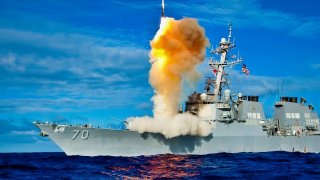Destroying Houthi and Iranian Missiles Has Cost $1 Billion
The U.S. Navy has spent approximately $1 billion countering missile and drone attacks from Iran and the Tehran-backed Houthis in the Middle East, as detailed by Secretary of the Navy Carlos Del Toro.
Summary: The U.S. Navy has spent approximately $1 billion countering missile and drone attacks from Iran and the Tehran-backed Houthis in the Middle East, as detailed by Secretary of the Navy Carlos Del Toro. This expenditure has been incurred over six months due to direct attacks on U.S. Navy and merchant ships, with air defense missiles like SM-2s, SM-6s, and SM-3s being used extensively. Del Toro highlighted the financial strain this has placed on military resources, emphasizing the urgent need for supplemental funding of $95 billion to replenish munitions. The ongoing situation has seen the U.S. Navy maintain a strong defensive record, though the financial implications for U.S. taxpayers are significant, particularly as the cost of interceptors significantly exceeds that of the missiles they are designed to destroy.
U.S. Navy Spends $1 Billion on Missile Defense in Middle East, Seeks Additional Funding
It has cost around $1 billion to counter the missiles and drones fired by Iran and the Tehran-backed Houthis in the Middle East, the United States Navy's leading civilian official told lawmakers on Tuesday.
“We have actually countered over 130 direct attacks on US Navy ships and merchant ships,” Secretary of the Navy Carlos Del Toro said at a Senate Appropriations Subcommittee on Defense budget hearing for the upcoming fiscal year.
Over the past six months, the sea service has fired nearly $1 billion in air defense missiles to counter aerial threats from Iran and its proxy forces. The disclosure underscores the depth—not to mention the rising financial cost—of the U.S. Navy's involvement in the Middle East.
U.S. warships and aircraft have been operating in the Red Sea since October, and in addition to shooting down a significant number of Houthi missiles and drones, preemptive strikes have also been carried out against the militant group in Yemen.
It has been a costly undertaking and that was before the United States and its allies helped intercept Iranian ballistic missiles and drones during Tehran's unprecedented attack on Israel.
“We currently have approaching $1 billion in munitions that we need to replenish at some point in time,” Del Toro added. “So, therefore the over $2 billion that's provided for in the supplemental is direly critical to our Navy and Marine Corps to be able to replenish those munitions and continue to provide the types of defensive measures that we have this past six months now.”
The secretary further called upon lawmakers to approve $95 billion in supplemental funding.
“I would argue that the president's budget numbers are adequate, but that's also prior to the attacks that we've just had this weekend alone, for example. So we are now closely approaching $1 billion in expenditures for munitions that we need paid back by the supplemental,” said Del Toro, who added, “We've been firing SM-2s, we've been firing SM-6s, and just over the weekend SM-3s to actually counter the ballistic missile threat that's coming from Iran. So we need this supplemental to pass this week.”
The Senate passed the supplemental in February; yet the Republican-controlled House has yet to bring it to a vote.
A Costly War of Attrition
The U.S. Navy maintains a near-perfect record in countering missiles fired by the Houthis, with only a handful striking commercial vessels and none hitting any U.S. warships. However, it is a war of attrition that is going to be very costly for U.S. taxpayers.
Defense One reported, “Interceptor missiles are roughly twice as expensive than the anti-ship missiles they are built to destroy. Variants of the Standard Missile-3 run from $9.7 million to $27.9 million apiece. (The missile made its combat debut this weekend, when the Navy fired ‘four to seven’ of them during the defense of Israel.) SM-2s run just over $2 million each and SM-6s go for about $3.9 million.”
In its 2025 budget request, the sea service has further asked for $6.6 billion to build on its multi-year purchases of critical munitions, which include: Standard Missile; Naval Strike Missile; Long Range Anti-Ship Missile, or LRASM; and Advanced Anti-Radiation Guided Missile, or AARGM, Chief of Naval Operations Adm. Lisa Franchetti said in her written testimony.
“Additionally, the Navy is investing in industry and in its organic industrial base to ensure we can ramp up munitions production in the immediate future. Building upon the FY23 and FY24 requests, the FY25 budget request invests $227 million to expand capacity for Trident II, Long Range Anti-Ship Missiles, Standard Missiles, and MK-48 torpedoes. We welcome supplemental funding to help replenish munitions expended in the Red Sea,” Franchetti wrote.
Author Experience and Expertise: Peter Suciu
Peter Suciu is a Michigan-based writer. He has contributed to more than four dozen magazines, newspapers, and websites with over 3,200 published pieces over a twenty-year career in journalism. He regularly writes about military hardware, firearms history, cybersecurity, politics, and international affairs. Peter is also a Contributing Writer for Forbes and Clearance Jobs. You can follow him on Twitter: @PeterSuciu. You can email the author: [email protected].


